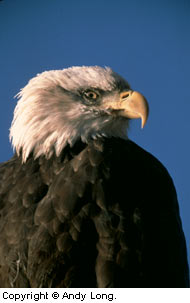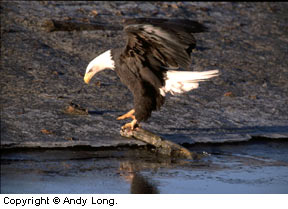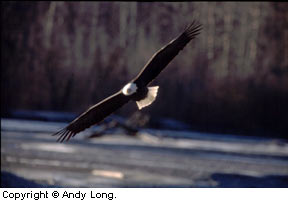 When the bald eagle is mentioned as our national symbol they really mean it.Of all eagles found in the world, it’s the only one unique to North America.With a range covering almost the entire country, it definitely lives up to being our national symbol.
When the bald eagle is mentioned as our national symbol they really mean it.Of all eagles found in the world, it’s the only one unique to North America.With a range covering almost the entire country, it definitely lives up to being our national symbol.
Even though the bald eagle was made our national symbol in 1782, people haven’t treated it as such.It is believed there may have been as many as 75,000 nesting bald eagles in the lower 48 states at that time.Due to habitat loss, illegal shooting, and contamination of its food source, most notably the pesticide DDT, fewer than 450 nesting pairs remained by the early 1960s.Numbers also decreased from lead poisoning as a result of feeding on waterfowl wounded with lead shot.
Despite all that happened to almost eliminate the bald eagle in the lower 48 states, much has been done to help its recovery.One way was with a five- year program by the U.S. Fish and Wildlife Service (USF&WS) to halt the use of lead shot for waterfowl hunting.
Another program the USF&WS undertook was to gather the largest group of breeding bald eagles in captivity at its Patuxent Wildlife Research Center near Laurel, MD.
They enhanced the breeding potential by removing a pair’s first clutch of eggs and incubating them.The pair would usually lay a second clutch which the birds were allowed to incubate themselves. In all, 124 bald eagles were hatched at Patuxent.

Bald Eagle dragging a freshly caught salmon onto bank.
These captive-hatched bald eagles enhanced populations in some areas and helped to reestablish a broader distribution.The program ended in 1988 as bald eagles began to reproduce more successfully in the wild and the center turned its efforts toward other endangered species.
This did not end reintroduction efforts though, as individual states continue to use one of several methods to enhance the bald eagles’ numbers.Eaglets used for reintroduction may be captive-hatched as was done at Patuxent, or may be taken as newborns from nests since usually only two young per nest survive.These eaglets are placed in the nest of an adult pair whose own eggs failed to hatch for whatever reason.The adult eagles then adopt the chicks and raise them as their own.
These and other recovery methods, as well as habitat improvement and banning DDT, have seen bald eagle numbers increase to nearly 4,500 adult nesting pairs and an unknown number of young.Because of this, the bald eagle has been taken off of the endangered list and is now regarded as threatened in the lower 48 states.
While habitat loss still remains a threat to the bald eagle’s full recovery, most experts agree its recovery to date is encouraging.Soon our national symbol soaring the skies may become a common sight for Americans to once again behold.
Behavior

FLIGHT – Their large body and wingspan are no mistake.They’re shaped to enhance flight.Their long flat wings allow them to get maximum airlift.When adjusted just right, the wing slots let them keep a steady flight pattern, maneuver and enhance lift so they can carry prey.A light body weight for their size, their air-filled skeleton makes their body weight less than half of their 7,000 feathers, allowing them to soar like they do.
FEEDING -Eagles are primarily fish eaters but will eat anything they can find.Their feeding comes in three forms: hunting, stealing or scavenging.Hunting is done by soaring until they find something and diving down for it or by sitting on a perch until they see something and then taking flight after it.Bald eagles are known thieves.They will harass another bird, usually a smaller eagle or an osprey, with food in tow, make it drop it, then swoop down and grab the dropped food in midair.As scavengers, they will feed on most any carcass they can come across.After feeding, especially in winter, you will see the birds sitting high in a tree.They will spend a majority of their time there conserving energy after feeding.
MATING – Pair bonding begins in late winter with spectacular midair displays which include locking talons and descending in a series of somersaults, separating and flying apart just before they hit the ground.They build or add to large platform nests that are used year after year and normally lay one clutch of one to three eggs.Incubation time is 34 to 36 days with the eaglets able to fly within three months and are on their own about a month later.Young are born several days apart and in lean feeding years only the older one will survive.
Hot Spot
Lake McConaughy near Ogallala, NE, near the northeast corner of Colorado.Several hundred bald eagles converge on the area in late winter to feed on the dead and dying fish in the lake.If one corner of the lake remains unfrozen the birds congregate near there to spend the day feeding.
By Andy Long

Leave a Reply